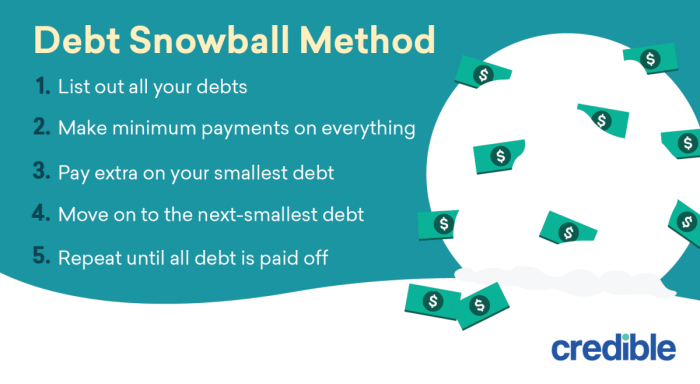Yo, diving into the world of credit card debt snowball method, where you tackle those bills like a boss. Get ready to learn how this method can help you crush that debt game and level up your financial freedom.
So, picture this: you’ve got a bunch of credit card debts piling up faster than you can say ‘show me the money.’ That’s where the credit card debt snowball method swoops in to save the day.
Introduction to Credit Card Debt Snowball Method
The credit card debt snowball method is a strategy used to pay off multiple credit card debts by focusing on one debt at a time while making minimum payments on the others. Once the first debt is paid off, the money that was being used to pay that debt is then rolled into paying off the next debt, creating a “snowball” effect.
How the Method Works
- Make a list of all your credit card debts from smallest to largest.
- Pay the minimum on all debts except the smallest one.
- Put as much extra money as you can towards paying off the smallest debt.
- Once the smallest debt is paid off, move to the next smallest debt and repeat the process.
- Continue this cycle until all debts are paid off.
Benefits of Using the Snowball Method
- Provides a sense of accomplishment by paying off debts one by one.
- Keeps you motivated to continue paying off debts.
- Reduces the number of debts you have to keep track of.
- Can help improve your credit score by reducing overall debt and making on-time payments.
Steps to Implement the Credit Card Debt Snowball Method
When it comes to tackling credit card debt using the snowball method, it’s essential to follow a structured approach to maximize its effectiveness. Let’s break down the step-by-step process for implementing this debt repayment strategy.
1. Prioritize Credit Card Debts
- List out all your credit card debts, starting from the smallest balance to the largest.
- Make minimum payments on all debts except the one with the smallest balance.
- Allocate any extra funds towards paying off the smallest debt first, while continuing to make minimum payments on the rest.
2. Snowball Effect
- Once the smallest debt is paid off, move on to the next smallest debt while adding the freed-up payment amount to the new debt’s minimum payment.
- Continue this snowball effect, gradually increasing the payment amounts towards larger debts as you clear off the smaller ones.
3. Maximize Effectiveness
- Consider reallocating discretionary spending towards debt repayment to accelerate the snowball effect.
- Look for additional sources of income or ways to cut expenses to free up more funds for debt repayment.
- Stay consistent and disciplined with your debt repayment plan to see significant progress over time.
Comparison with Other Debt Repayment Strategies
When comparing the credit card debt snowball method with the avalanche method, it’s essential to understand the key differences and benefits of each approach.
Snowball Method vs. Avalanche Method
- The snowball method focuses on paying off the smallest debt first, regardless of interest rates. This approach provides a psychological boost by creating small victories along the way.
- On the other hand, the avalanche method prioritizes paying off debts with the highest interest rates first. This approach saves money in the long run by minimizing interest payments.
Pros and Cons of the Snowball Method
- Pros:
- Provides a sense of accomplishment by clearing smaller debts quickly.
- Keeps motivation high as you see progress sooner.
- Simple and easy to follow, especially for those who need a clear plan.
- Cons:
- May cost more in interest payments compared to the avalanche method.
- Not the most financially optimal strategy in terms of interest savings.
Scenarios Favoring the Snowball Method
- If you have multiple debts with varying balances and struggle to stay motivated, the snowball method can help you gain momentum by tackling smaller debts first.
- For individuals who value psychological wins and need a structured approach to debt repayment, the snowball method provides a clear roadmap to becoming debt-free.
Tips for Success with the Credit Card Debt Snowball Method

When using the credit card debt snowball method, it’s essential to stay motivated and avoid common pitfalls. Tracking progress and celebrating milestones can help you stay on track towards financial freedom.
Staying Motivated
- Set clear goals: Define specific targets for paying off each credit card to keep yourself motivated.
- Reward yourself: Treat yourself with small rewards when you reach milestones to stay encouraged.
- Visualize the end goal: Imagine the financial freedom and reduced stress that comes with being debt-free.
Avoiding Common Pitfalls
- Avoid adding new debt: Resist the temptation to use credit cards for unnecessary purchases.
- Stick to the plan: Follow the snowball method consistently without getting sidetracked.
- Communicate with creditors: If you face financial difficulties, don’t hesitate to reach out to creditors for assistance.
Tracking Progress and Celebrating Milestones
- Use a debt tracker: Keep a record of your payments and progress towards each credit card balance.
- Celebrate small victories: Acknowledge each debt paid off and celebrate the progress you’ve made.
- Share your success: Share your achievements with friends or family to stay accountable and motivated.






